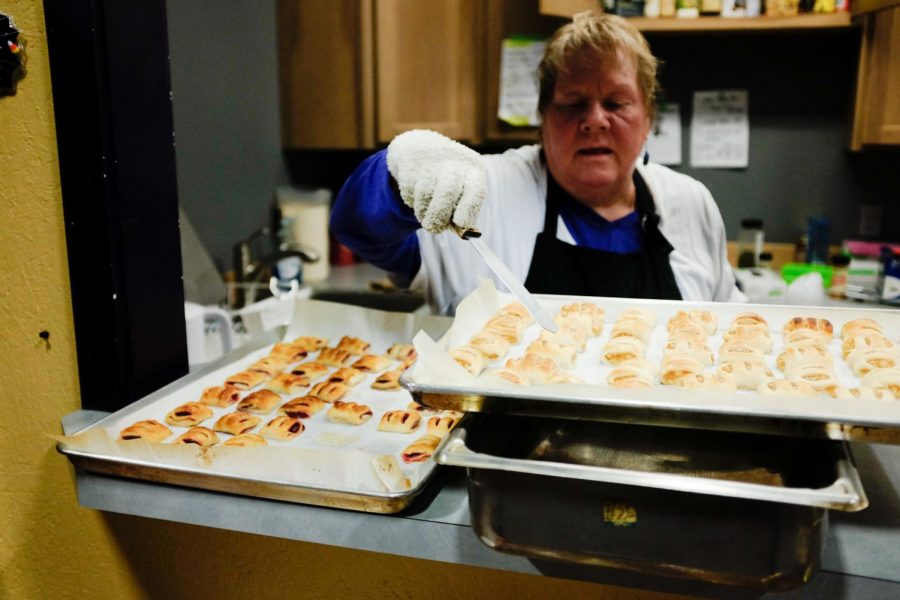FISH Food Bank puts the “unity” back in community
Lori Fritts, the kitchen manager at the FISH food bank, manages the hot meals that are served. She does all her cooking with the oven, crock pot and toaster pan located in their kitchen.
November 9, 2017
As the holidays approach and the days get shorter, many students and faculty find themselves traveling or going home for many consecutive weekends. During these weekends there is usually plenty of food, family and great discussion for some, but not for all.
“It all started in 1971, when a group of church people here in the community saw a need to feed neighbors. They saw neighbors that were hungry and they wanted to help them,” Peggy Morache, interim executive director of the FISH food bank, said.
Hidden behind the Mercer Creek Church, over on North B Street, lies a resource that has been serving the community and people of Ellensburg for over 46 years. Since the early years, FISH food bank grew past its roots as a neighborly helper and expanded to include food, resources and programs that can assist anyone in the community who needs them.
Throughout the summer FISH provided hot meals to elementary, middle and high school students, through USDA (United States Department of Agriculture), who rely heavily on the meals provided by the school. This last summer, within the 45-day period that the program runs, program volunteers passed out about 700 meals to kids.
School supplies are another resource that might be difficult to fund. Each year, FISH food bank puts on a school supplies donation for kids who are in need of school supplies.
“The kids get to go through and shop, pick up a backpack. We coordinate it with the list of supplies that the schools are recommending for the various class levels,” Morache said. “That way kids can go to school feeling confident that they have the materials that they need. This year we had nearly 200 kids that came through.”
Last year, the FISH Food Bank dispersed roughly 500,00 lbs of food and basic necessities to people in need throughout the communities of Kittitas Valley. This is all thanks to their large base of 200 yearly volunteers and three paid staff, according to Morache.
Rick Toomey, a volunteer at FISH Food Bank in Ellensburg, supervises and assists other volunteers. Toomey’s jobs include shopping with the people in need and making sure that donation bins are are always full to the brim.
“We never decline food. If someone donates it, we find someway to use it,” Toomey said.
Even though FISH gets a majority of it’s food from the community and through food drives, the two of which in November and March help provide them with enough resources to help families for half the year, they still contract two food trucks to come monthly with fresh produce to donate. One of the trucks is a government truck, and the other is from Second Harvest, a distribution food bank who assists over 250 regional food banks with food. Second Harvest is also aided with help from over 8,000 volunteers.
Throughout the FISH food bank warehouse, pallets of apples are stored in refrigerators and canned goods and other milk products are stored in a distribution room. Volunteers move fresh produce and goods from the warehouse to the distribution room. Volunteers also help out food bank recipients with gathering food and additional resources.
Though things are looking decent with the amount of volunteers and extra produce that is coming in, Morache believes that there is always more that is needed and more that can be done to help the people throughout the community.
“This is where we serve the opentable hot meals three days a week, and dinner on saturday. It’s not ideal, I mean we need a commercial kitchen and we need things that we don’t have, so we’re really looking for options around that,” Morache said, referring to their small kitchen attached to their gymnasium.
Morache is also hoping that more students from CWU will use the food bank as a resource in their time of need. During the winter, when heating and electric bills skyrocket, Morache understands that it can be difficult to supplement some additional income to make sure food is on the plate.
“We think we’re a great resource for some of the students at CWU, if they would use us. We don’t get a lot of students, but we’re here and we have food and it’s available,” Morache said.


